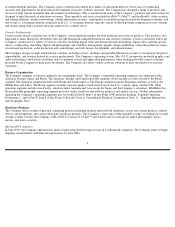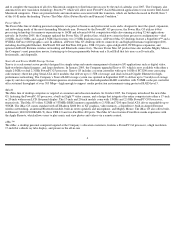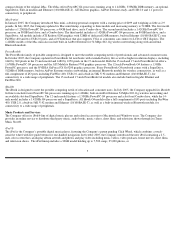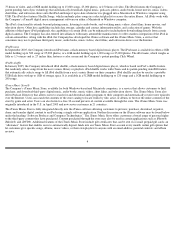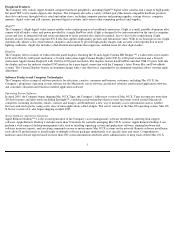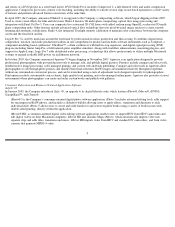Apple 2005 Annual Report Download - page 15
Download and view the complete annual report
Please find page 15 of the 2005 Apple annual report below. You can navigate through the pages in the report by either clicking on the pages listed below, or by using the keyword search tool below to find specific information within the annual report.
cataloguers. No individual customer accounted for more than 10% of net sales in 2005, 2004, or 2003. The Company also sells many of its
products and resells certain third-party products in most of its major markets directly to consumers, education customers, and businesses
through its retail and online stores in the U.S. and internationally. Over 12% of the Company’s net sales in 2005 were through its U.S.
education channel, including sales to elementary and secondary schools, higher education institutions, and individual customers.
Competition
The Company is confronted by aggressive competition in all areas of its business. The market for personal computers and related software and
peripheral products is highly competitive. This market continues to be characterized by rapid technological advances in both hardware and
software that have substantially increased the capabilities and use of personal computers and have resulted in the frequent introduction of new
products with competitive price, feature, and performance characteristics. Over the past several years, price competition in the market for
personal computers has been particularly intense. The Company’s competitors who sell personal computers based on other operating systems
have aggressively cut prices and lowered their product margins to gain or maintain market share. The Company’s results of operations and
financial condition can be adversely affected by these and other industry-wide downward pressures on gross margins.
The principal competitive factors in the market for personal computers include price, relative price/performance, product quality and reliability,
design innovation, availability of software, product features, marketing and distribution capability, service and support, availability of hardware
peripherals, and corporate reputation. Further, as the personal computer industry and its customers place more reliance on the Internet, an
increasing number of Internet devices that are smaller, simpler, and less expensive than traditional personal computers may compete for market
share with the Company’s existing products.
The Company is currently taking and will continue to take steps to respond to the competitive pressures being placed on its personal computer
sales as a result of innovations from competing platforms. The Company’s future operating results and financial condition are substantially
dependent on its ability to continue to develop improvements to the Macintosh platform in order to maintain perceived functional and design
advantages over competing platforms.
The Company’s services and products relating to music and other creative content have already encouraged significant competition from other
companies, many of whom have greater financial, marketing, and manufacturing resources than those of the Company. The Company faces
increasing competition from other companies promoting their own digital music products and distribution services, subscription services, and
free peer-to-peer music services. The Company anticipates that competition will intensify as hardware, software, and content providers work
more collaboratively to offer integrated products competing with the Company’s offerings. However, the Company believes it currently
maintains a competitive advantage by more effectively integrating an entire solution, including the hardware (iPod), software (iTunes), and
distribution of third-party digital content (iTunes Music Store).
Raw Materials
Although most components essential to the Company’s business are generally available from multiple sources, certain key components
(including microprocessors and application-specific integrated circuits (“ASICs”)) are currently obtained by the Company from single or
limited sources. Some other key components, while currently available to the Company from multiple sources, are at times subject to industry-
wide availability constraints and pricing pressures. In addition, the Company uses some components that are not common to the rest of the
personal computer and consumer electronics industries, and new products introduced by the Company often initially utilize custom components
13


